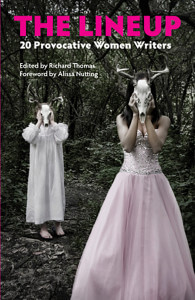By Jacob Singer
 “I turned entirely to provocative fiction and poetry, as I do during all my most desperate times (xi),” Allisa Nutting declares in the forward of The Lineup: 20 Provocative Women Writers. Later she explains her attraction to inappropriate art, how it challenges social prescriptions through a feeling of disgust. “Provocative writing and art is a restorative form of honesty,” she writes. “For many like myself, it’s one that is vital to sanity. I do not believe I could survive without it” (xiii).
“I turned entirely to provocative fiction and poetry, as I do during all my most desperate times (xi),” Allisa Nutting declares in the forward of The Lineup: 20 Provocative Women Writers. Later she explains her attraction to inappropriate art, how it challenges social prescriptions through a feeling of disgust. “Provocative writing and art is a restorative form of honesty,” she writes. “For many like myself, it’s one that is vital to sanity. I do not believe I could survive without it” (xiii).
Obviously, she is on to something. Superficial civility fills our lives. And the guise of manners is not strong enough to cover the social inequality and injustice of this day. Provocative art has become my daily dose of medicine—something like a punch in the gut, an incendiary action that makes me take notice. And this collection is full of rabble-rousers.
In The Lineup, Tina May Hall tells a story of thirteen beastly characters that are a far cry from the caricatures on television sitcoms. Ethel Rohan writes of a woman who sacrifices reality for her own delusions. Holly Goddard Jones’ short story is unforgiving and unrelenting (it made me want to cry in public). Monica Drake drops her protagonist off in a snow-covered parking lot at two in the morning to show what the American Dream has become for so many: “But why did I worry where my parents went? I had what I needed: a house, a car, a job. A dog. Pretty much, the American dream” (41). Except it is an empty house, a broken car, and a shitty job.
At some point in my thirties I started listening to punk and reading H.P. Lovecraft, Jan Potocki, and Edgar Allen Poe. I couldn’t put my finger on it until I read Allisa Nutting’s forward. What I needed was something provocative for my most desperate times. It was not that my life was bad—I just couldn’t stand reading anything that resembled realism. The news of the day felt Gothic, seemed manic, like the American Dream was slipping into one of García Márquez’s banana republics. Personally, many of the tools used in realism failed to get to the “truthy center” of my experiences. But neither did Lovecraft and Poe. Their characters lacked a dynamism. Their language felt a bit flat.
What makes this collection more than a bunch of genre writers? They’re well written. They use language with more elegance and nuance—and as a whole there is a range to the subjects and styles. That’s what makes it provocative. But each story points towards a darkness in life. Reading them will stir emotions and leave you changed. And that is why these stories are important and why you should read this anthology. Because it will help all of us deal with the mess called life. Realism has failed me—at least on some level—because its tricks have run dry. It doesn’t seem to affect me, its approaches have become stock and recognizable. I hunger novelty, something provocative and slightly perverse.
Speaking of freshness, before picking up this anthology I had not read any of these writers. For me that is thrilling. I had no expectations. Reading this book felt like giant leap into the periphery—like finding a new aisle in my favorite bookstore. The editor Richard Thomas pins this feeling down in his introduction—it’s about risk taking and strong reactions. You only get that by being provocative, defiant, edgy, and enticing (xv). These elements aren’t typically found in mainstream Hollywood, television, or literature. Yes, there are exceptions. But in general the big businesses that are acting as gatekeepers aren’t looking to alienate its audience with provocative material—that’s never good for the bottom line. Sometimes even our favorite authors, who you have been obsessively reading for years, fall flat. Every once in a while, we readers need to leap toward our literary boundaries and find uncharted territories to explore. For me this collection felt like washing ashore the island of Lilliput.
The Lineup: 20 Provocative Women Writers
Edited By Richard Thomas
Black Lawrence Press
ISBN 978-1-62557-915-7









